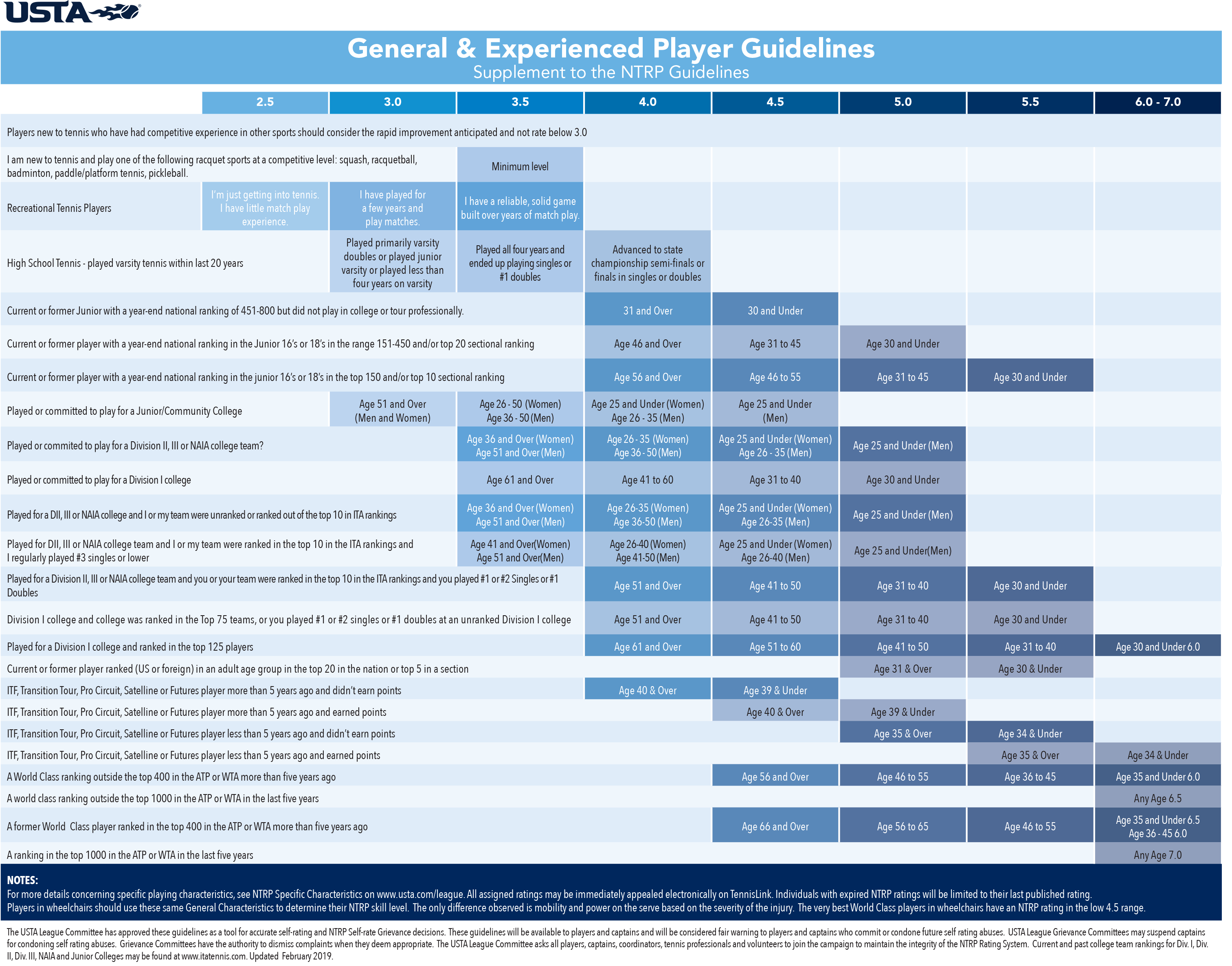Calculate your tennis league ranking, learn how you stack up against the rest, and pair up with other players at similar levels.
Are you interested in learning about the rating criteria and how to Calculate Your Tennis League Rating? A good place to start is with USTA.com rating guidelines. We’ll help you learn about NTRP ratings and how to calculate yours. Here are the steps:
- Take a Tennis Ratings Quiz
- Learn the rating levels
- Find players to help you practice and increase your tennis level
- The first step is to calculate your tennis league ranking, learn how you stack up against the rest, and pair up with other players like you. A simple tennis rating quiz is a great way to get a start on your likely level, so you can drill down to the other criteria within that level and dig deeper.
- The next step to calculating your NTRP rating is to learn what all of the tennis rating levels mean. For example, if you think you are stuck at a 3.0 but want to move up to a 3.5, what should you focus on?
- Find tennis players to help you move up. Playing with tennis partners at or just above your level will help you improve your game. Focusing on your weak spots by observing better techniques, and defending against harder strokes will definitely help.
Other ideas for you are to watch tennis learning videos, find a good coach, and also play as many practice games as possible. If you are a singles player, consider some doubles matches as well.
USTA Ratings Explained
How NTRP Ratings Are Used in League and Tournament Play
When a player is new to the USTA system, they can complete a self-rating survey to be issued a self-rated NTRP rating.
Within the Adult tennis league season or for a tournament that a player enters, the match play is recorded by the USTA. At the end of the year these results are used to calculate each player’s NTRP rating for the next year.
The NTRP system is always changing. A player’s rating is intended to go up with improvement or go down if skills fall. The goal is to find players at your level with which to enjoy a competitive game of tennis.
The NTRP Rating Numbers Defined
| Rating Number | NTRP Rating Number Description from NTRP website |
|---|---|
| 1.0 | Just learning tennis. First few lessons, beginner level. |
| 1.5 | A tennis player with very limited court experience. This player is working on basic strokes and serves, trying to keep a ball in play. |
| 2.0 | BEGINNER: This player knows how to hit all of the strokes, but lacks court experience. They are familiar with the basic court positions for singles and doubles. |
| 2.5 | At this level, this beginner player is learning to judge where the ball is going although court coverage is fairly weak. They can sustain a short rally of slow pace. Note: This is the lowest rating level for which the USTA offers League play. |
| 3.0 | HIGH BEGINNER: This player is consistent when hitting medium paced shots, but they are not comfortable with all strokes. This player’s shots lack directional control and power. |
| 3.5 | INTERMEDIATE: These players have achieved dependable strokes with directional control on moderate paced shots yet still lack depth and variety. This player is starting to show team work in doubles. This ranking is considered intermediate level. |
| 4.0 | HIGH INTERMEDIATE: This player has very dependable strokes including directional and depth control on both the forehand and backhand sides. This player can use ground strokes, volleys, lobs, overheads, and approach shots with success. This player occasionally forces errors. Rallies are often lost due to impatience. This player shows strong teamwork in doubles. This level considered the measuring stick in USTA league tennis. |
| 4.5 | BEGINNER ADVANCED: In addition to directional and depth control, this player has begun to master the use of varying spin and power. This player can handle considerable pace and shows sound footwork. They can vary their game plan according to opponents. They can vary their serve and have placement of their second serve. This player tends to over hit on difficult shots. In addition to sound doubles team work, this player often shows aggressive net play. This is the beginning of the advanced ratings. |
| 5.0 | ADVANCED: Players show return and serve anticipation and often has an outstanding play or attribute around which their game may be structured. Players can regularly force errors and hit winners from short balls. In addition to power and placement, they can spin and place second serves. |
| 5.5 | SENIOR ADVANCED: These tennis players have developed power and consistency as a major weapon. This player can vary strategies and styles of play in competitive situations and hits dependable shots when under pressure or stress. |
| 6.0, 6.5, & 7.0 | PROFESSIONAL: These players have intensive training for National programs or the Pro tour. They have National or Sectional ratings and are considered Tennis Professionals. Most tennis coaches fall into this category. |
USTA NTRP rating descriptions: www.usta.com/Play-Tennis/USTA-League/Information/About_NTRP/

![The Top 10 Things That Are Costing You Wins In Matchplay [Part 2]](https://www.playyourcourt.com/news/wp-content/uploads/2020/04/The-Top-10-things-that-are-costing-you-wins-Part-2-.jpg)
![The Top 10 Things That Are Costing You Wins In Matchplay [Part 1]](https://www.playyourcourt.com/news/wp-content/uploads/2020/04/The-Top-10-things-that-are-costing-you-wins-Part-1-1.jpg)
